by scott.gillum | Jan 4, 2015 | 2015
It’s the time of the year to look back over the last 12 months and create a “best of” list. This year I’ve pulled the most popular posts from five different sites; Adage, Business2Community, Forbes, Fortune and LinkedIn. In addition, I’ve thrown in a few other noteworthy nuggets from the year at the end of the post.
Adage – Why Apple Pay Could be Huge, And It’s Not What You Think explored the potential upside of Apple Pay as an advertising platform. It sparked the most conversation, and debate, on Twitter. Time will tell if they this strategy will come to fruition.
Business2Community – 5 Key Tips and Da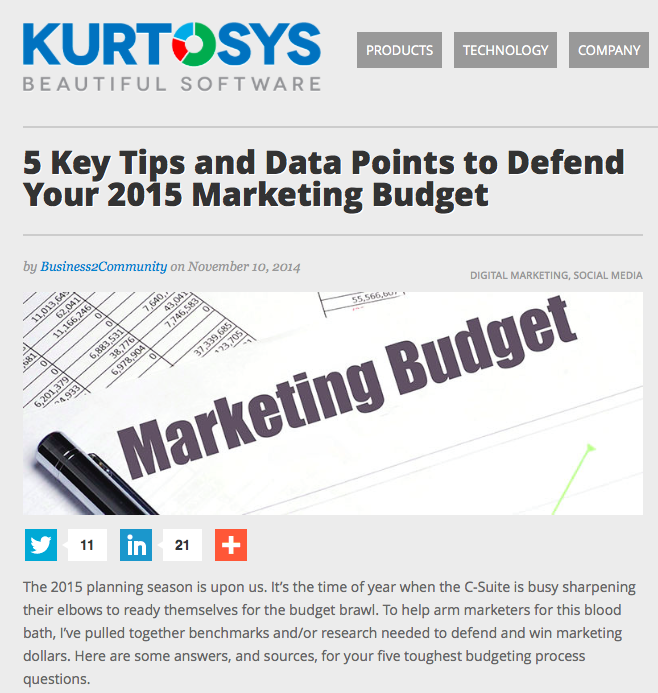 ta Points to Defend You 2015 Marketing Budget. The last post of the year required the most man hours, and it was the most reposted story of the year. It offers marketers help with their 2015 planning activities in the form of free research and benchmark data.
ta Points to Defend You 2015 Marketing Budget. The last post of the year required the most man hours, and it was the most reposted story of the year. It offers marketers help with their 2015 planning activities in the form of free research and benchmark data.
Forbes -the most popular and shared post of the year, Could Falling Test Scores Be a Good Thing for the US? explores the link between test scores and success in business. It also highlights the risk associated with over emphasizing left brain analytic skill development, outlined by Sir Ken Robinson in his Ted Talk video Do Schools Kill Creativity? The endorsement of Marc Andreessen certainly played a big role in the popularity of the post.
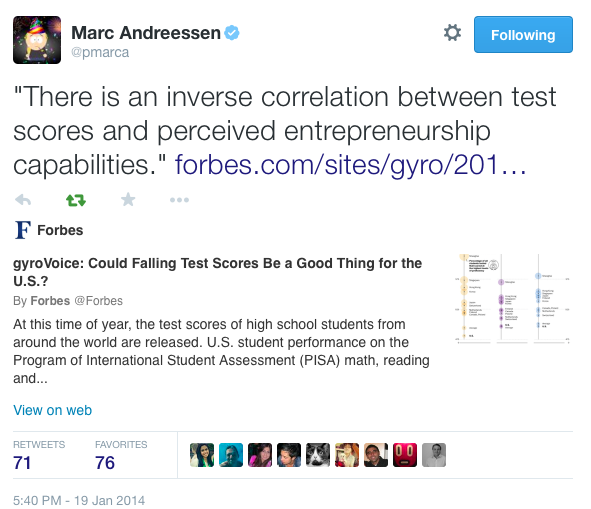
Fortune – Are Marketers Measuring the Right Things was the first post I wrote for our new partnership with Fortune. It profiles the efforts of Ciena, a networking company, to elevate marketings role, and importance, within the organization. The post highlights an unique survey tool used to gather feedback from the sales organization on the performance of marketing (see the dashboard below).
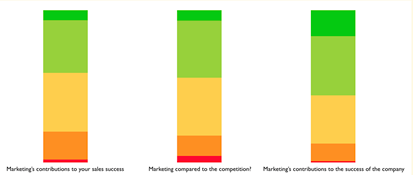
LInkedIn – 2014 marked my first year publishing on LinkedIn. Based on my experience so far, I’m not convince it will viable platform for content unless it becomes better policed. Too much promotional material seems is making its way on to it. At this point, I’m not sure I’ll continue to post.
That said, the most popular post on LinkedIn was also one of the most popular on Adage. The Keys to Differentiating Your Company From Others provides tips on how marketers can humanize their corporate brand to better resonate with audiences. It also identifies one of the common flaws of B2B communication – thinking that what you sell…is who you are. Hopefully, it also helped generated a new client for a follower.

Bonus Stuff
A couple of other noteworthy happenings from the year.
Moving on up.
The Next Generation of Apps Will Be All About You post that ran on Advertising Age was reprinted in the Sept/Oct version of The Portal magazine, a bi-monthly publication produced by the International Association of Movers.
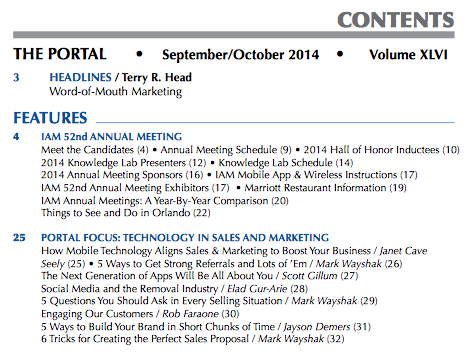 Taking Center Stage
Taking Center Stage
Karen Walker, SVP at Cisco, highlighted my post Everything We Thought We Knew About B2B Marketing is Wrong in her presentation at this year BMA member meeting in Chicago. The post now has close to 70,000 views.
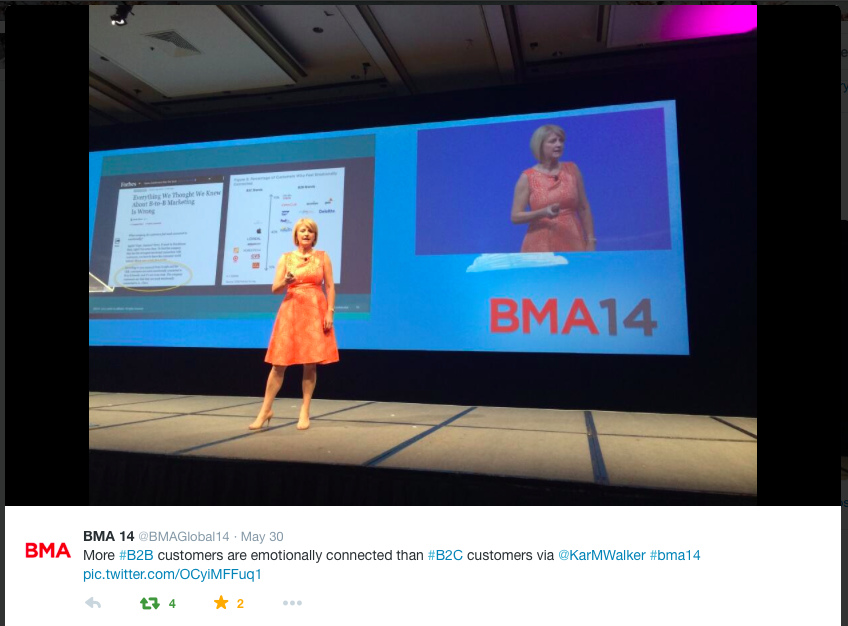
Happy New Year! Here’s to an exciting year to come.
by scott.gillum | Nov 7, 2014 | 2014, Marketing
The 2015 planning season is upon us. It’s the time of year when the C-Suite is busy sharpening their elbows to ready themselves for the budget brawl. To help arm marketers for this blood bath, I’ve pulled together benchmarks and/or research needed to defend and win marketing dollars. Here are some answers, and sources, for your five toughest budget questions.
- How much should we be spending on marketing? It’s a classic question and a favorite of CEO’s everywhere. The mere mention of it is enough to stop marketers in their tracks. Fortunately, the AMA, McKinsey and the Duke Fuqua School of Business have got your back with their 2014 CMO Survey. Section 3 of the report contains data from 350 marketers on their spending from digital to people and programs. The research even breaks spending out by size of company, type of company (B2B or B2C, and B2B products or services). The report is packed with valuable information — it’s a “must have” for any marketer this year.
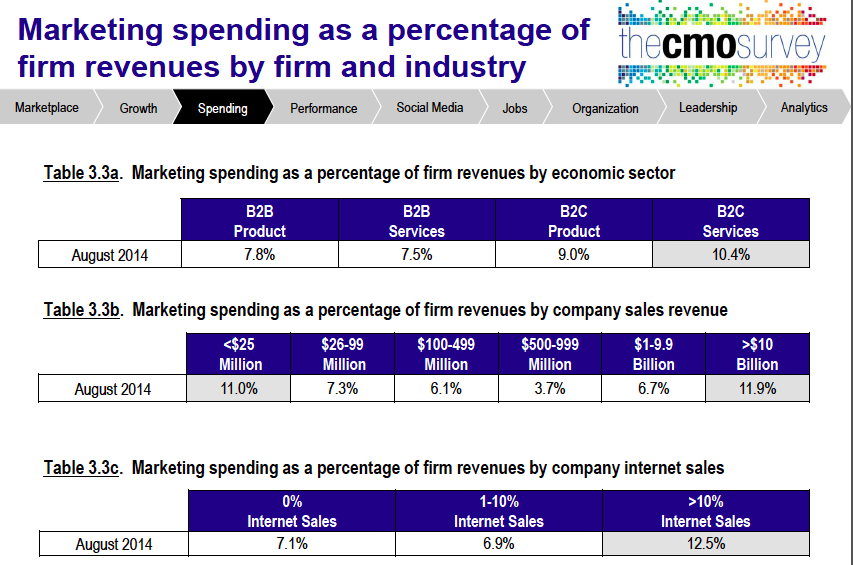
- What should the mix between people and programs? This question comes shortly, if not immediately, after the question above. Ten years ago the general benchmark ratio was 40/60, forty percent of the budget went to staff and the remaining to program spending. Now it’s the reverse, 60/40 people to program spending, for a number of reasons. The biggest factor has been the need for specific skill sets that are in high demand relating to analytics, social media and content marketing have driven up staff cost. Need more information, here’s a useful infographic on the real cost of social media, including salary cost for staff.
- Where should we invest? Typically, this is a teaser question, and could also be asked as; “if you had an incremental $1 (or $10K, $100K, etc.) where would you invest it?” Keep in mind that just because the CEO is asking the question doesn’t necessarily mean you’ll get the incremental funding, but you better be able to answer the question. To do that see IBM’s C-Suite Priorities report entitled The Customer-activate Enterprise. The research, collected from face to face interviews with over 4000 senior executives, provides insights into the priorities of each member of the C-Suite. The top priority in the report is Digital. Including everything from increasing responsiveness to customers, to making the organization more agile and responsive. Specific priorities for CMO’s, it’s about capturing; analyzing and using customer data across touch points.
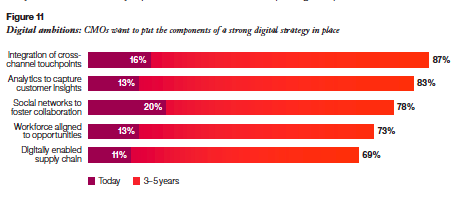
- What’s the payoff/return/business impact of Social Media? There are a number of sources that you could tab into to help develop a response. I’ve always been a fan of HubSpot’s State-of-Inbound. Additionally, if you have downloaded the CMO Study mentioned in bullet #1, there is a whole section on Social Media (see graphic). Interestingly enough after four years “Visits” and “Followers/Friends” are still the leading social media metrics today. Personally, I’m not a fan, try using measurements related to engagement. Note the gains being made in “Conversion Rates” and “Buzz Indicators” over that last four years. This is the result of the development of better measurement tools. Here’s a great cheat sheet from SocialMediaToday on the Top 50 Tools. For digital and mobile benchmarks download Adobe Digital Index’s Best of the Best Report.
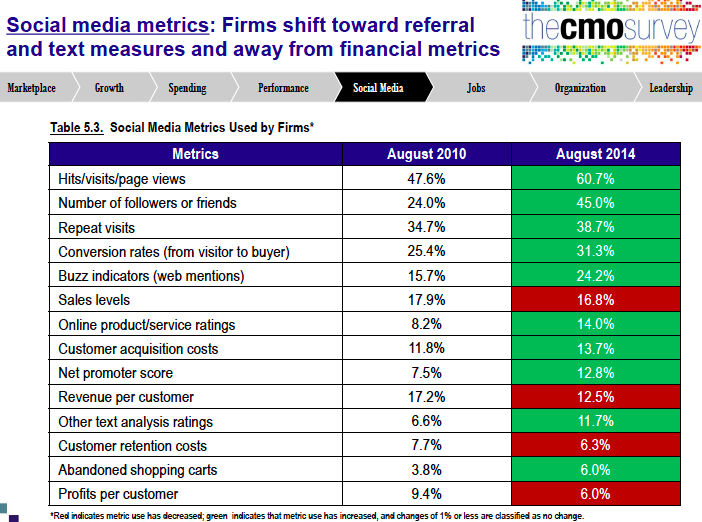
- What return should we expect from our marketing investments? This is a loaded question. Recognize that what the executive really wants to know is: “What will marketing do for me and/or my group?” As a result, answer the question based on their area of interest, and in their language. If it’s a sales executive, talk in terms of new leads, customers and pipeline value. If it’s the CEO, talk about brand value, revenue growth or customer retention or loyalty. Rarely is this question asked on behalf of the organization as a whole. Even more rare, is the executive that believes the numbers you’ve quantitatively derived for a ROI.
Lastly, go in strong and ask for a bigger budget. Here’s a report to keep in your back pocket in case you need it, Gartner’s CMO Spend 2015: Eye on the Buyer. The report will support your request for an increase, and maybe help the “powers that be” understand that if you’re not getting a bigger budget, your key competitors probably are…now go get ‘em!
by scott.gillum | Jan 2, 2013 | 2013, Sales
Twenty-five years ago, I was a snot-nosed kid out of college who suddenly decided that law school was not in the future. With a recession on, and needing to pay the rent, I took the first job offered and went into sales.
Having learned nothing about the profession in college, I picked up a copy of Miller Heiman’s Strategic Selling — still have a dog-eared copy on my bookshelf. I learned everything I could about the buyer types, account management, and the sales process. “Know the process work the process,” as my first sales manager used to say.
Typically, that process came down to 5-to-7 steps that generally covered the following areas below.

Over the years, I found that working the process helped give you sense of control. It came down to the numbers; calls, leads, transaction sizes or conversion rate. Call on X number of qualified prospects to get Y amount of proposals, at Z close rate, and you made bonus.
But, research from Google and CEB entitled The Digital Evolution in B2B Marketing provides new insight into buyer behavior, and it challenges the conventional wisdom. According to the study, customers reported to being nearly 60% through the sales process before engaging a sales rep, regardless of price point. More accurately, 57% of the sales process just disappeared.
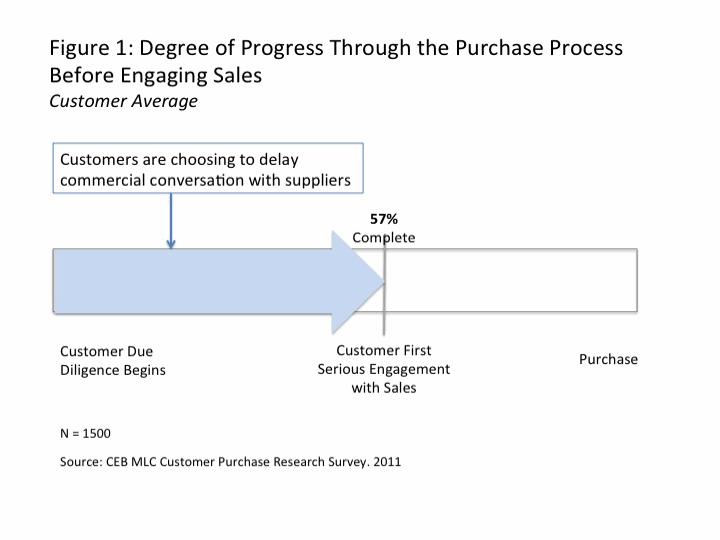
What are buyers doing if they’re not talking to sales? Well, they’re surfing corporate websites to identify and qualify vendors, instead of the sales forces qualifying them. They are engaging peers in social media to learn more about their needs, potential solutions, and providers. And they’re reading, listening to, and watching free digital content that is available to them at the click of a mouse. No longer is the sales force the sole source of information.
What does this mean for sales and marketing?
The study recommends focusing efforts in three areas; 1) improve marketing communication integration, 2) develop and activate a content strategy, and 3) strengthen multichannel analytics. Nothing new or breakthrough here, but the study provides good examples of how companies are executing against each point.
However, I found a number of other points to take from the research.
- It is not all bad news – for products or services with low price points and/or margins, having customers self direct themselves through the sales process can help reduce the cost of sale and/or create leverage for the sales force. In fact, in certain situations an organization will want to encourage and/or incent this behavior. The research also found that some customers felt comfortable going through 70% of the process before making contact.
- Changing buying behavior – an old manager used to say that technology changes fastest, then consumer buyer behavior, and eventually, organizations. The “57%” stated in the research makes for a good sound bite; the fact is, that number will vary, greatly by customers, transaction, industry, etc. The point is that change is a constant; the question is how far ahead or behind is your sales and marketing efforts? Are you keeping pace? The second question is, how would you know?
- Content Distribution – as the study notes, the sales force is still the most effective and important communication channel. When developing the content strategy ensure that the best and/or most valuable content is not in the public domain, reserve it for the sales force.
- Time to Take Social Media Seriously – with well-informed prospects, sales reps have to quickly learn what buyers know or perceive about the organization, products/services and competitors. Social media can help them better understand what is motivating buyers to take action, what buyers believe to be true, and perhaps most importantly, who they believe.
The Future
Business decision makers will continue to drive their buyer process deeper into the sales process. As a result, relevant content will continue to escalate in value, especially content related to consideration and purchase drivers, and the business application of the product or service.
Social media and monitoring has helped many marketing organizations understand this trend and to make the transition from being content “dictators” to information “facilitators.”
For sales, the research may be an epiphany. No longer can it be successful focusing solely on an inwardly directed process intended for reporting and planning purposes.
With ever-increasing knowledgeable buyers waiting longer to engage, sales has to transition from being a “product pusher” following a process, to an insight “provider” adding value to the buyers business. As the study states, sales must deliver “pointed insights and evidence that seek to challenge an entrenched point of view among potential customers.”
Finally, it is time to recognize that we’re not in control, and perhaps we never were. The traditional sales process is now obsolete; it is now time to follow the buyers’ journey.
by scott.gillum | Dec 6, 2012 | 2012, Tech Trends
Years from now, will we look back and realize that Apple’s biggest innovation was not device, but rather a physical gesture?
The right-to-left swiping motion used with Apple devices to sort through photos or to navigate certain apps is quickly altering how we seek and absorb information.
David Payne, chief digital officer of Gannett & Co. Inc., parent company of USA Today, delivered this point eloquently at the 2012 Mid-Atlantic Marketing Summit. In his opening speech, he pointed out that the digital world changed when Apple introduced “touch” with the iPod and iPhone.
Touch screens had been around for years, but Apple brought them into our daily lives, in particular with the iPhone. As a result, the way we engage and interact with devices has changed, as evidenced by the dramatic decline in sales of the BlackBerry. And now with the explosive growth of the iPad, it’s about to change again. This time, though, it will be even more dramatic.
Payne referred to the “swipe” as the game-changer, or as he called to it, “petting the cat.” This new right-to-left world has caused Gannett to rethink the traditional “top-to-bottom” experience of its websites, in particular how it organizes content. As evidence, Gannett has incorporated this new “petting the cat” thinking into its new USA Today app (it’s worth downloading).
Last week, Fast Company ran a story on a new technology MIT developed that enables users to drag files across devices with a swipe. Coincidentally, it’s called Swyp. Nathan Linder, a PhD student in the fluid interfaces group at the MIT Media Lab, said, “Our framework allows any number of touch-sensing and collocated devices to establish file-exchange and communications with no pairing other than a physical gesture.”
Apple’s impact on design has enjoyed much acclaim and is noticeable in almost any new technology designed. But what may be overlooked is the impact Apple has had on the user experience and how users interact with technologies. And that impact goes far beyond just Apple devices.
For example, one attendee mentioned that his 3-year-old went up to the television and tried to “swipe” it to change the channel. A colleague mentioned that she is constantly cleaning her computer screen because her kids try to open photos on her desktop by touching them. Apple has, and continues to have, the ability to change consumer behaviors, requiring the rest of the world to catch up.
Marketers must now realize that we are a step behind. We recognize the importance of adapting digital assets to fit the device, but we haven’t thought through the ramifications of “petting the cat” behavior. The swipe is here to stay. It’s now time to reset our navigation point from North to South to East to West.
by scott.gillum | Jul 12, 2012 | 2006
Original post December 21, 2006
I am soooo over the hype on the “second coming” of the Web. So here’s my Christmas present to you. Do you want to know what Web 2.0 is about?
The media has been hyping it for what seems like an eternity but I still haven’t seen a good simple explanation. Some like BtoB magazine are even calling it a “Revolution”.
Here’s what I think 2.0 is really about …it is about creating an engaging and useful online experience that is designed by your targeted audience…and of course, all the web tools/applications to enable this (Blogs, Podcast, Social Networks, etc.). Yes, that’s it. Creating opportunities within your digital properties to let visitors give you feedback on their experience — and you (Company X) actually paying attention and doing something about it.
The best part is that you don’t have to wait until the hype and new technologies start rolling out to build your own Web 2.0 site right now. In fact, you probably already have pieces of “Web 2.0” in site right now. A few tips for getting started:
- Track/Determine Interaction Time and/or Engagement Level– go beyond measuring typically web metrics (traffic, clicks, etc.) to measuring Interaction Times. Determine not only if the visitor is returning to your site but also how much time are they spending on it. You also need to understand where they have come from, your sales process by product, where customers spend their time (in what channel to learn, shop and buy) and finally, how long it takes (on average). Hi-Tech customers, for example, surf among channels (both online and offline). Complex sales, as you would expect take much longer and consume more Face-to-Face resource time.
- Build Information “Depots” – if you want customers to give you feedback, give them something to respond to and an opportuntity to do so by giving them vehicles/channels to communicate. HP is experimenting with giving IT professionals new media tools such as Blogs to engage with customers. And Intuit has created a feedback button called “We Hear You” that enables Quickbook users to submit product feedback. Keep in mind, if you want something of value (information) you have to give something of value. If you don’t have an even exchange you will not get the information you want…so get those offers together (white papers, research, etc.).
- Go beyond Community Building – You’ll hear a lot of hype around “communities” and many of you probably have robust user communities. Get the communities more involved in building, testing and promoting your products, website, campaign,etc. Start measuring “Net Promoters” – a metric of customers who would recommend your products. Word of mouth is still THE most powerful marketing tool, but with recent regulatory changes, be careful on how you motivate customers to sing your praises.
- Leverage Existing Tools – years ago we started to leverage an Online Training tool called Brainshark. It allowed us to create On Demand sales and marketing presentations using PowerPoint and a phone…very simple and convenient. But the most valuable part of the tool was the tracking. We were able to see who was viewing the presentation as soon as they opened it, how long they viewed it, how many pages and who they sent it to, etc. We able to measure the interest levels inside a company, decide on who to pursue and predict when we would acquire the account — all by watching how people interacted with us in a “virtual” world. This functionality now resides in most Webcast tools so make sure you are taking advantage of your investments in Webex, Placeware, etc.
- Before, At and After the Web – think about what information you want to collect at each of those stages. Also, think about what you want the visitor to see and retain in each of those areas. This is the “customer experience”. Organize and integrate your activities by segment (customer, product, etc.) against these three stages to create a seamless experience that reinforces your message. With complex products/solutions, for example, each stage should communicate a portion of the total message, and subsequent stage should reinforce the previous stage. Breaking the message up into pieces and then, hopefully, rebuilding it in the mind of the visitor piece by piece as they go throught the buying process. So a customer may see a TV ad, then visit your website and finally call you contact center to place the order. You must anticipate, plan and, hopefully, direct the customer buying behavior to drive the response, conversion, close and yield rates.
The bottom line is that Web 2.0 is not “revolutionary”. The concept is not new, in fact, if we had to do the first round of the Web all over again we would of done it this way…let your visitors/customers design your website the way they want to use it. But what might be different this time is that I think we are ready to listen to them.
Have a great holiday! Talk to you in the New Year.
 ta Points to Defend You 2015 Marketing Budget. The last post of the year required the most man hours, and it was the most reposted story of the year. It offers marketers help with their 2015 planning activities in the form of free research and benchmark data.
ta Points to Defend You 2015 Marketing Budget. The last post of the year required the most man hours, and it was the most reposted story of the year. It offers marketers help with their 2015 planning activities in the form of free research and benchmark data.















